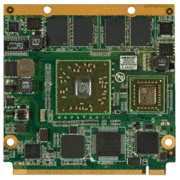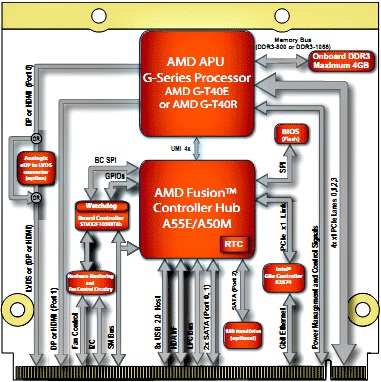AMD G-Series processors leap to the Qseven format
Oct 5, 2011 — by LinuxDevices Staff — from the LinuxDevices Archive — 3 viewsCongatec announced a Qseven module that's offered with single- or dual-core AMD G-Series processors clocked at 1.0GHz. The Conga-QAF comes with 2GB or 4GB of RAM, supports dual displays, includes multiple I/O interfaces, and is offered with onboard SSD (solid state drive) options up to 32GB, the company says.
The Conga-QAF uses the 2.75 x 2.75-inch Qseven module format that Congatec launched in 2008 (as part of a 14-member consortium that also included MSC Vertriebs and Seco, among others). As such, it has a 230-pin "golden finger" connector, using Nvidia's MXM (Mobile PCI Express Module) format, that sends all its I/O to and from a baseboard.
Congatec has launched two other Qseven modules to date: the Conga-QA6, with an Intel Atom E6xx processor, and the Conga-QA, with the original Atom Z5xx CPUs. The new Conga-QAF turns to the single-core AMD G-Series T40R or dual-core T40E, both clocked at 1.0GHz.

Congatec's Conga-QAF
Congatec's overall Qseven product page suggests that the Conga-QAF (above) enters at the bottom of its range. Ironically, though, the device should play back HD video better than the Intel-equipped modules, thanks to the presence of AMD's Radeon HD 6250 graphics (clocked at 280MHz).
Per AMD specs, the T40R and T40E have TDPs of 6.4 and 5.5 Watts, respectively. The Conga-QAF is equipped with AMD's A55E I/O controller and either 2GB or 4GB of soldered-on memory, according to Congatec.
Congatec says the Conga-QAF is also available with an onboard, SATA-interfaced SSD, which may be ordered in capacities up to 32GB. Offering two SATA ports, the module also provides four PCI Express x1 expansion lanes, the company adds.

A block diagram of the Conga-QAF
According to Congatec, the Conga-QAF supports DisplayPort and HDMI video outputs with resolutions up to 1920 x 1200 pixels. An LVDS display, which may be hooked up simultaneously, can be driven at up to 1400 x 1050 pixels.
Signals relayed to a baseboard include gigabit Ethernet, eight USB 2.0 ports, SDIO, L2C, and LPC. There's also high-definition audio and two ExpressCard interfaces, Congatec says.
Congatec's data sheet says overall power consumption for the Conga-QAF has yet to be determined, but adds that the module features ACPI (Advanced Configuration and Power Interface) 3.0 support and may be operated on batteries. Equipped with a multi-state watchdog timer, the module is said to be compatible with Linux 2.6, Windows 7, Windows XP, and Windows Embedded Standard.
Specifications listed by Congatec for the Conga-QAF include:
- Processor — single-core AMD G-Series T40R or dual-core T40E, both at 1.0GHz
- Chipset — AMD A55E
- Memory — 2GB or 4GB of DDR3 RAM; optional SSD (up to 32GB via SATA interface)
- Expansion interfaces — 4 x PCI Express x1 lanes; 2 x ExpressCard
- Networking — 1 x gigabit Ethernet
- Other I/O:
- LVDS
- DisplayPort 1.1a or HDMI 1.3
- 8 x USB 2.0
- 2 x SATA
- 1 x SDIO
- 1 x I2C
- 1 x LPC
- high definition audio
- Operating range — 32 to 140 def. F
- Power consumption — n/s, but battery-operable
- Dimensions — 2.75 x 2.75 inches
Further information
Congatec did not provide pricing or availability information on the Conga-QAF. However, more information on the device may be found on the Conga-QAF product page.
This article was originally published on LinuxDevices.com and has been donated to the open source community by QuinStreet Inc. Please visit LinuxToday.com for up-to-date news and articles about Linux and open source.